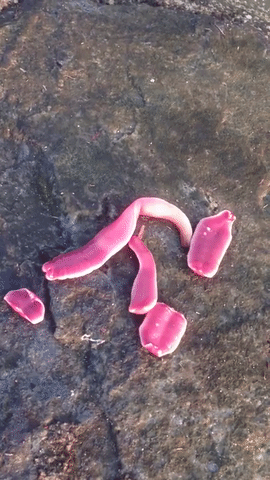Aww.., this creepy RIBBONWORM
Ribbon worms are undeniably weird, so it's not surprising that curious humans sometimes can't resist showing off the animals when they find them. But a filmed encounter with one of these strange creatures,is a good example of why marine life is best left alone [scroll down for the full video].
The title of the YouTube video refers to a "multiplying worm", and it's not that hard to see why the uploader mistook the find for a "creepy" cohort of five pink invertebrates:
However, what you're looking at is actually just a single individual – and this worm is under an immense amount of stress.
Because their delicate bodies rely on water pressure to hold everything in place, ribbon worms do not fare well away from the ocean environment. In fact, they typically survive for only about ten minutes in the open air.
Nemertean specialist Dr Sebastian Kvist, who is also an associate curator of invertebrates at Royal Ontario Museum, noted that the animals sometimes fall apart if handled. When this happens, the severed pieces can continue wriggling around like animated copies of a parent worm.
We checked in with Kvist about this more recent encounter, and he confirmed that the ribbon worm in the video was in very bad shape. "My best guess is that the worm is dying and that's why it's breaking apart," he explained.
There isn't much information about where the sighting was filmed, but we suspect that the worm belongs to the genus Gorgonorhynchus. Out of the 1,000 or more known species of ribbon worms, only a handful possess a branching proboscis like this one.
The fleshy tube is an infolding of the body wall that can evert like the finger of a rubber glove – and if you watch the footage closely, you'll notice that the worm actually discards it.
"The reason for the expelling of the proboscis is that the worm thinks that it is attacked," said Kvist. "It's trying to leave the proboscis behind for the predator so that it can escape – it's trying everything to stay alive."
Kvist adds that while some nemerteans can regenerate lost body parts like earthworms, no records of that remarkable ability exist for this species. So even if the ribbon worm somehow stayed alive long enough to be returned to the sea, it would no longer have been able to hunt.
It seems very unlikely that the unfortunate creature ended up on a dry rock by natural means. Most ribbon worms live on the sea floor, and many hide out beneath shells and amongst mussel beds. This choice of habitat leaves the animals particularly vulnerable to accidental catch.
Should you be lucky enough to spot one of these rarely seen worms in the wild, resist the urge to handle it. And if you happen to find one lurking in your shellfish catch, always release it as soon as possible.


Comments
Post a Comment